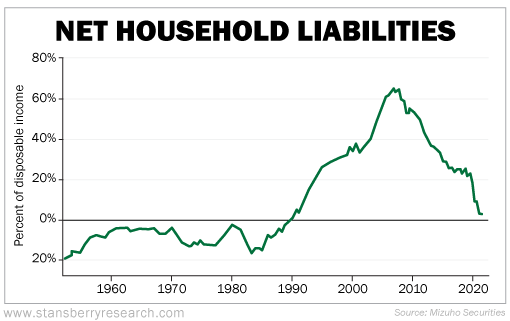From 1990 to 2009, we went on a credit binge...
While many of our parents taught us values like "only buy things you can afford," low interest rate loans and credit cards make it too easy for folks to "buy now and pay later."
Unfortunately, over the last few decades, the U.S. has adopted a buy-now-and-pay-later mentality. And as you may know, taking on debt is a slippery slope.
You can quickly find yourself in over your head and in serious trouble. We've all heard the horror stories. Perhaps, you've been a part of one yourself.
The chart below looks at net household liabilities as a percentage of disposable income. Household liabilities include the combined debt of all people in a household, such as mortgage loans and credit cards. Disposable income is the amount of money that a household has to spend or save after income taxes have been deducted.
Before the 1990s, net household liabilities as a percentage of disposable income was around 0%. Folks only bought what they could afford.
But then we started binging on credit. That ratio shot up to nearly 70% right before the housing bust in 2007. Of course, the financial crisis devasted many families all throughout the country.
You can see in the chart that over the past decade, especially the last couple years, U.S. household deleveraging has been extraordinary.
Thanks to the pandemic, folks have been spending less and saving more. Net household liabilities as a percentage of disposable income has finally come down to reasonable levels.
It really is refreshing to see Americans finally getting their debt levels in check.
The only question is: will this last?
After all, Americans have a love affair with their credit cards and low interest rate loans. As the economy has been reopening, it has prompted many to get out of their houses and spend.
Plus, since it's already November, a lot of folks have Christmas spending on their mind.
A recent survey from CreditCards.com found the average parent with children under 18 years old plans to spend $276 per child on gifts. Meanwhile, folks with significant others plan to spend $251 on gifts for them.
It wouldn't surprise me if parents, grandparents, siblings, and loved ones will spend a little more this year than they did last year. It's been a brutal couple years, after all, thanks to COVID-19.
Everyone deserves time with their loved ones to celebrate the holidays.
One thing I hope I won't see is folks falling back into the habits of running up their credit cards.
If you've been reading Health & Wealth Bulletin for a while, you'll know I'm a huge advocate of saving. There will always be times where you'll need cash for some unexpected expenses... So at the bare minimum, you should have enough saved to cover three to six months' worth of expenses like mortgage payments, food, and utilities.
Always make sure you have your emergency fund fully funded before you even think about pulling out your credit card.
Also, if you're dealing with credit-card debt and missed our issue from two weeks ago, we put together a couple ways to conquer credit-card debt. One is called the "debt snowball" and the other is called the "debt avalanche."
These two strategies help you come up with a plan to tackle your credit-card debt and save you money in the process. Again, you can read that issue here.
It really is a breath of fresh air that Americans have finally deleveraged credit card debt... Let's hope it stays this way for a while.
What We're Reading...
- Here's how holiday shoppers can avoid getting into debt.
- Something different: Macy's raises hourly wage to $15 and rolls out college tuition to try to win workers.
Here's to our health, wealth, and a great retirement,
Dr. David Eifrig and the Health & Wealth Bulletin Research Team
November 10, 2021

